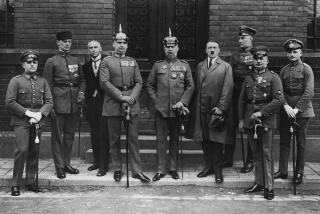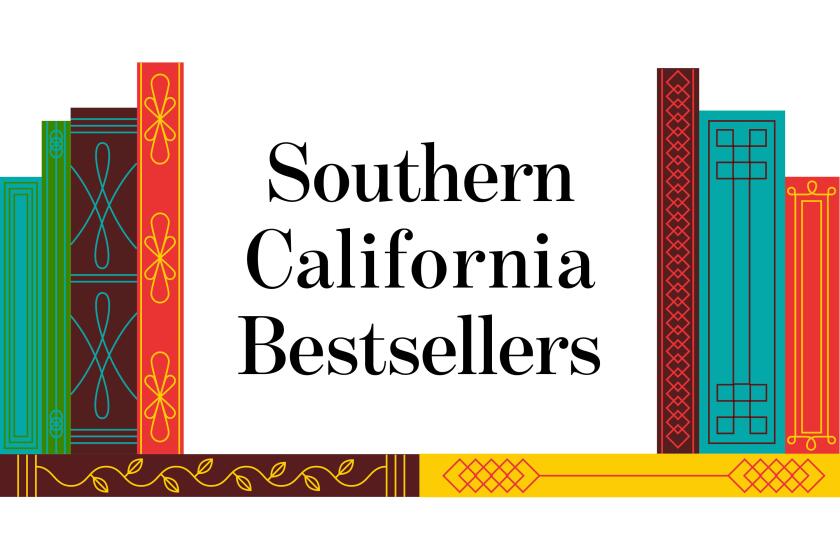History’s Bloodiest Hands : HITLER AND STALIN: Parallel Lives, <i> By Alan Bullock (Alfred A. Knopf: $35; 1,024 pp.)</i>
- Share via
In the long, sad cavalcade of history’s most wicked men, Hitler and Stalin seem unrivaled as the most effectively and influentially evil. As individuals, they may have been no more ruthless, no more vengeful, no more amoral, no more megalomaniacal than Attila the Hun or Genghis Kahn. But the fact that they lived in the 20th Century rather than the 5th or the 12th meant they possessed the means to do a great deal more harm. Between 1930 and 1950, Hitler and Stalin, between them, were responsible for the deaths of more than 40 million people--20 million killed as a direct result of World War II, but the same number again exterminated in prisons and concentration camps.
Who were these two terrible tyrants? How did they gain power in their respective countries? Why were their policies so barbaric? Why have they cast such a dark shadow across the 20th Century? Are we yet free of their blood-chilling legacy? It is to answer these questions that Alan Bullock has undertaken this remarkable dual biography.
This is a work neither for the lethargic nor the squeamish. At more than 1,000 pages, it is too long by half, and would have benefited from more stringent editorial pruning. And as an account of the depths to which man’s inhumanity to man can sink, it makes mind-numbing reading. Either way, it is a monster book about two monster men.
As Bullock points out, no one who knew Hitler or Stalin before they reached the age of 30 ever would have predicted that they would one day play starring roles on the stage of history. Stalin was born in Georgia in 1879, Hitler in Austria 10 years later. Both were outsiders, both were born in humble circumstances, and both soon came to smolder with feelings of generalized resentment against the world. In Hitler’s case, this was reinforced by his failure to make it as an artist in early 20th-Century Vienna; in Stalin’s, by successive spells of imprisonment in Siberia for his underground political activities.
Long before Hitler, Stalin found his true vocation in subversive politics. As a follower of Lenin, he played a minor part in the October Revolution of 1917 and a much larger part in the ensuing civil war. He became editor of Pravda, commissar for nationalities, and in 1922 general secretary of the Communist Party. By contrast, Hitler served as a corporal in World War I, was decorated with the Iron Cross, and only turned to politics in the aftermath of Germany’s defeat. He created the National Socialist Party, led an abortive putsch in 1923, spent nine months in prison and wrote “Mein Kampf,” in which he spelled out his bizarre political philosophy with brutal candor.
During the remainder of the 1920s, the two men’s fortunes continued to diverge. After Lenin’s death in 1924, Stalin outmaneuvered his rivals to the right and the left, forced through the collectivization of agriculture, in which millions died, and established a position of power that was effectively unassailable. Meanwhile, Hitler remained on the margins of German political life, but reorganized the Nazi Party, confident that his time would come. During the early 1930s, the collapse of the Weimar Republic gave him his opportunity. The Nazis made a sensational breakthrough in the poll (though they never won a majority of votes), and in 1932 Hitler became chancellor.
Having now got both his principals center stage, Bullock’s narrative gathers pace. Throughout the 1930s, Stalin pushed ahead with Russian industrialization, regardless of the cost in human lives, and began a series of ruthless purges, eliminating all leaders, military and political alike, whom he suspected of disloyalty. At the same time, Hitler began to build up Germany’s army and air force, and scored a succession of sensational diplomatic coups: the remilitarization of the Rhineland, the Pact of Steel with Italy, the annexation of Austria and the dismemberment of Czechoslovakia. The parallel lives of the two dictators effectively converged in the Nazi-Soviet Pact of 1939.
Thereafter, they briefly drew apart, as Hitler turned west and his troops blitzed and blasted their way into Scandinavia, the Low Countries and France. But his real aim was the establishment of a new German Empire in the east, and to this end, he invaded Russia in the spring of 1941. It was a fatal mistake. Although the German troops reached the outskirts of Leningrad, Moscow and Stalingrad, they failed to take any one of these cities. Stalin’s troops held firm, then counterattacked, and within two years the Russians gained the military initiative. Hitler’s war had now become Stalin’s war, and Hitler’s defeat was essentially Stalin’s victory.
While Hitler had hoped that Germany would dominate Eastern Europe and much of Russia, the result of World War II was that Russia came to dominate Eastern Europe and much of Germany. This was not an irony that the Fuhrer would have appreciated. Stalin soon tightened his grip on his satellite states (with the exception of Tito’s Yugoslavia), refused Marshall Plan aid, blockaded Berlin and erected the Iron Curtain. In Russia itself, he continued his policy of purge and rule, turned virulently against Jews and intellectuals, and only his death at the age of 74 seems to have prevented yet another savage round of denunciations and deaths.
Although weighed down with too much detail, Bullock’s book is a landmark in the comparative history of tyranny. Both Hitler and Stalin saw themselves as men of destiny, who would stop at nothing to fulfill their self-appointed world-historical roles. And in each case, it was the particular combination of character and circumstance that gave them their unique opportunities to do so much evil. In Russia, the power vacuum left by Lenin’s death enabled Stalin to impose his own brand of authoritarianism. In Germany, the widespread resentment of the humiliating terms of the Treaty of Versailles, combined with the collapse of the Weimar Republic, gave Hitler his chance.
Once in power, they continued to behave in recognizably similar ways. Both took delight in revenging themselves on men who earlier had ignored or despised them. Both imposed “revolutions from above” to secure and establish their authority. Both combined a novel ideology with traditional patriotic appeals. Both proved unexpectedly skillful in diplomacy, and in exploiting the weaknesses and divisions of their international adversaries. Both encouraged the cult of personality, and rewrote their nations’ histories in the light of it. And toward the end, both men became victims of their own propaganda, finishing their lives in a nightmare world of paranoid fantasy.
Yet the two men were also very different dictators. Hitler was an incomparable demagogue; Stalin was no orator. Hitler was generally loyal to his subordinates; Stalin thrived in an atmosphere of suspicion and distrust. Hitler’s totalitarian state was inefficient and disorganized; Stalin’s was better controlled. Hitler liked to preserve the facade of “legality”; Stalin did not care. Hitler refused to take advice from his generals, and lost the war; Stalin learned to listen to the military, and won. Hitler committed suicide; Stalin expired in bed. Hitler’s “thousand-year Reich” died with him; Stalin’s Communist bloc survived him by nearly 40 years.
Now that long night of barbarism is also ended, and much of Europe is uncertainly emerging into a new world, the contours of which are not yet clear. For Alan Bullock and his generation (he was born in 1914), this is a story with a happy ending: Nazism and communism have been relegated to the scrapheap of history; Europe has displayed astonishing vitality and recuperative powers; humanity has survived half a century of scarcely believable suffering and degradation. Despite the horrors of Auschwitz and the Gulag, this remains, in a more fundamental sense, a somberly heartening story.
More to Read
Sign up for our Book Club newsletter
Get the latest news, events and more from the Los Angeles Times Book Club, and help us get L.A. reading and talking.
You may occasionally receive promotional content from the Los Angeles Times.










